戴维·萨尔诺夫,霍华德·阿姆斯特朗以及超外差无线接收机
Posted 卓晴
tags:
篇首语:本文由小常识网(cha138.com)小编为大家整理,主要介绍了戴维·萨尔诺夫,霍华德·阿姆斯特朗以及超外差无线接收机相关的知识,希望对你有一定的参考价值。
超外差式收音机是如何诞生的?
01 超外差无线接收机
一、前言
收音机中的超外差接收方式是将两个高频信号混合在一起, 通过非线性电路和选频电路以产生低频信号,低频信号便于进一步放大检波。 根据维基百科,“几乎所有现代无线电接收器都使用超外差原理。”

▲ 图1.1.1 超外差式接收机
超外差式接收原理是怎么发明的? 又是如何工作的? 这与收音机如何变得流行有什么关系呢? 这些都与霍华德·阿姆斯特朗有关系。据说他是在遭遇到一次空袭轰炸中发明了它。 而大卫·萨尔诺夫则利用阿姆斯特朗的发明来创建了一个无线广播帝国, 成就了他的辉煌。 下面让我们听 Kathy 老师讲讲其中跌宕起伏的故事吧。
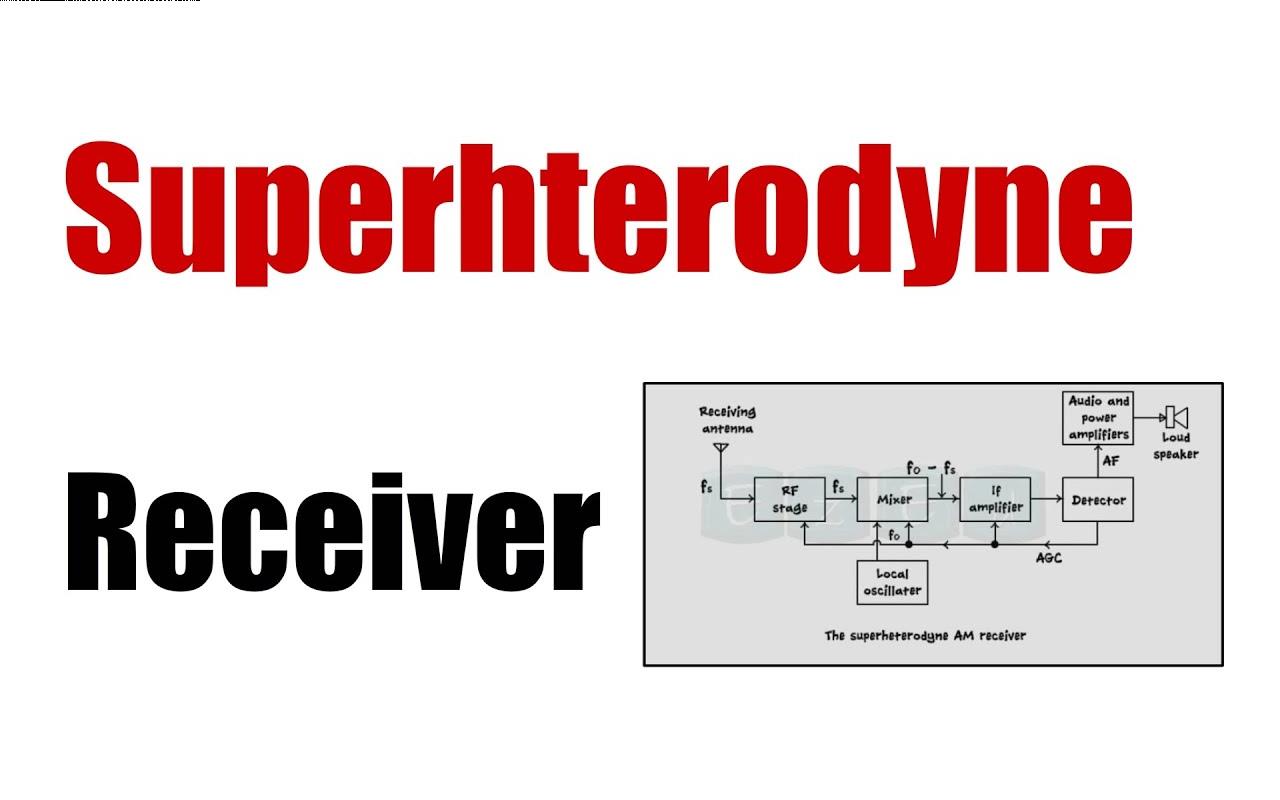
二、初出茅庐
让我们先从 David Sarnoff 谈起。 Sarnoff 于 1891 年出生于俄罗斯明斯克的 Shtetl,他的父亲是一位贫困潦倒的犹太画家。 在犹太作家Sholom Aleichem 的小说改编的歌舞剧,屋顶上的提琴手, 将其中的小提琴手’替换成画家,就是能够反映出他父亲的状况了。 当萨尔诺夫还是个孩子的时候,他的父亲离开俄罗斯前往美国寻找发财的机会。 但是,当萨诺夫、他的母亲和弟弟们在纽约与他团聚时,萨诺夫发现他的父亲还是穷光蛋一个。 在 9 岁那年,Sarnoff 不得不为家庭的生计奔波。 多年后他回忆起那个时候的生活,“就像被扔进一个漩涡,一个贫民窟的漩涡,任其沉没或漂流。”


▲ 图1.2.1 戴维·萨尔诺夫小的时候
Sarnoff 对无线的兴趣始于他为商业有线电视公司递送电报。 其实一开始他想在《纽约先驱报》工作来着,但一不小心走错了门。 然后,Sarnoff 从他每周 5 美元的薪水中拿出宝贵的 2 美元购买了电报按键。 然后他自学了发送电报的技术。 很快,他转而在马可尼公司工作, 偶尔在主要接线员生病时允许他发送无线信息。


▲ 图1.2.2 萨尔诺夫购买到的电报按键
1906 年 12 月的一天,公司大老板 吉勒莫·马可尼 (Guilermo Marconi) 亲自造访了他在纽约的办公室, 这个大胆的 15 岁年轻人向这位大老板作了自我介绍。 原本只是一个临时的谈话,谁成想他们两个人相谈甚欢, 一直持续到晚上才结束,Sarnoff 成为了 Marconi 在纽约的私人秘书,专门为 Marconi 在纽约的很多情妇传递信息。 在马可尼的支持下,萨尔诺夫成为一名初级电报员。
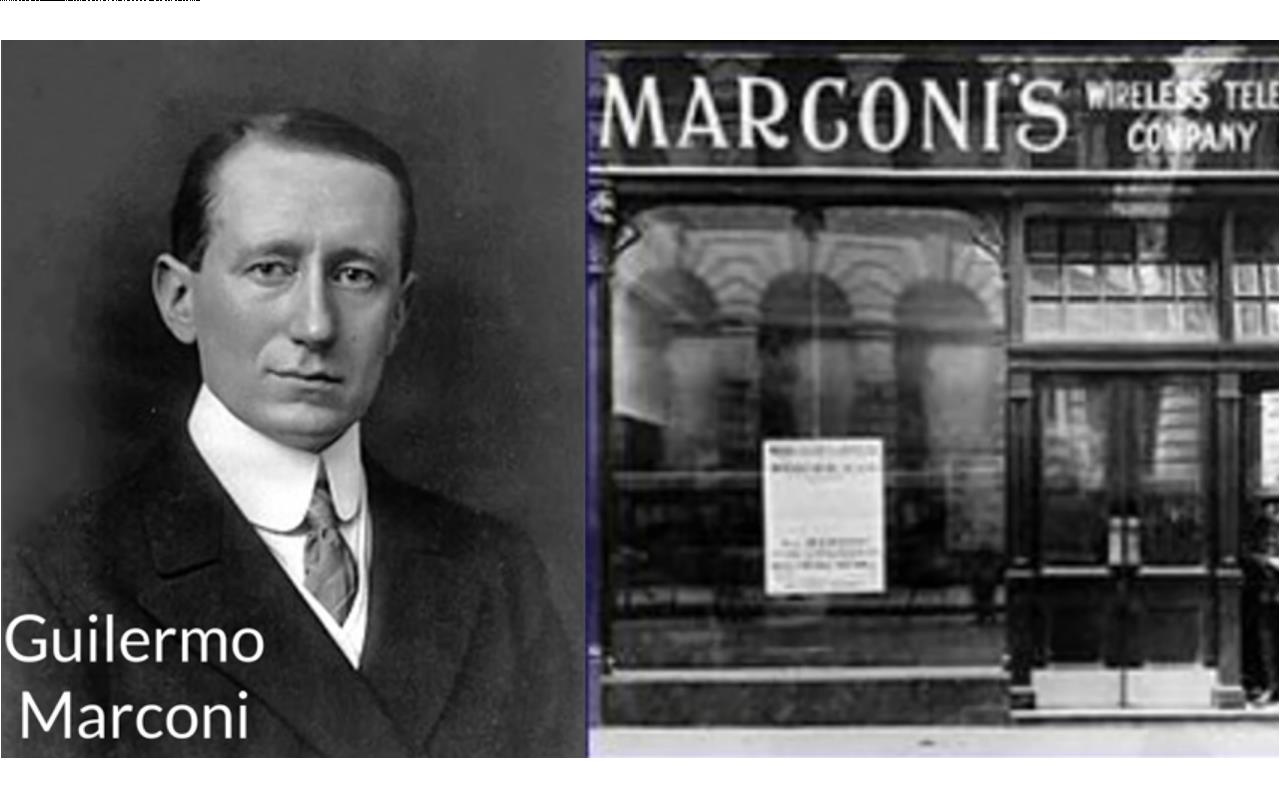
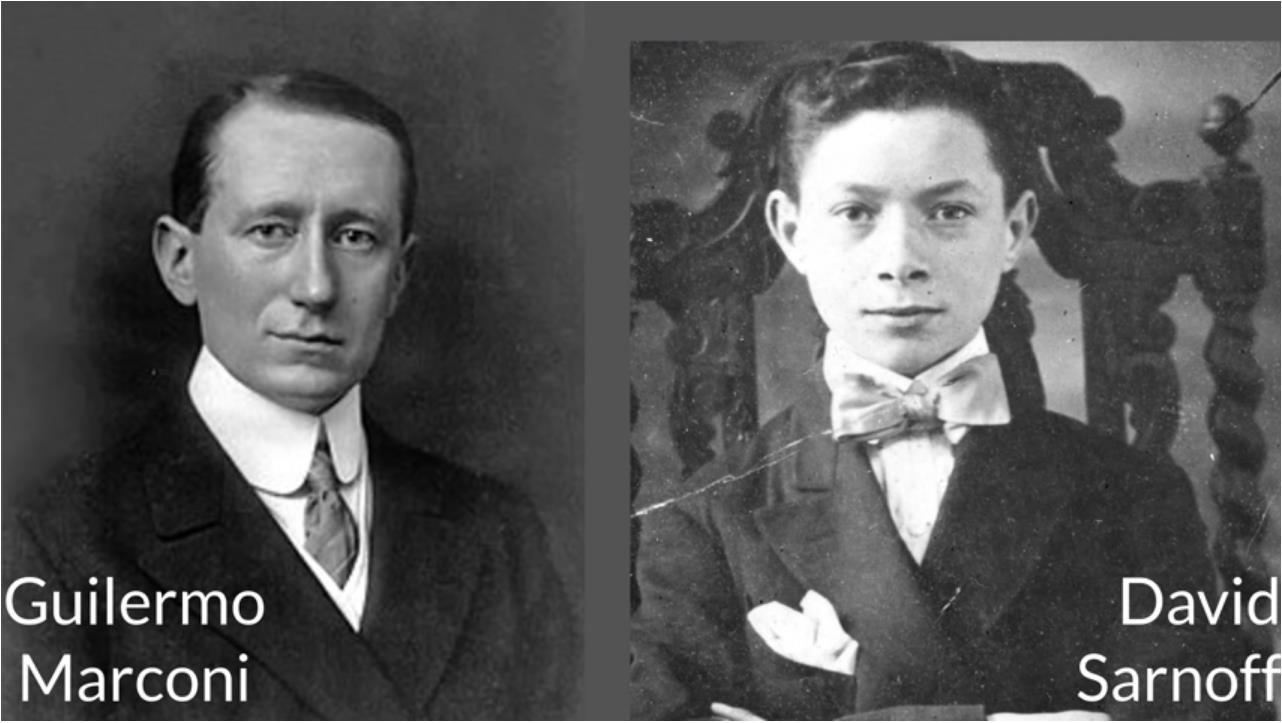
▲ 图1.2.3 马可尼与萨尔诺夫
三、得到提升
到 1912 年泰坦尼克号沉没时,他已经当上了当地电报局里的经理。 萨尔诺夫声称他是第一个在美国听到这个灾难的人。 实际上他不是,只是当时他还在进行接收电报工作。 他说自己连续熬了 3 个晚上才获得了泰坦尼克号沉没的消息。 由于他的英雄事迹,他被提升为首席检查员和总经理 Edward J. Nally 的得力助手。
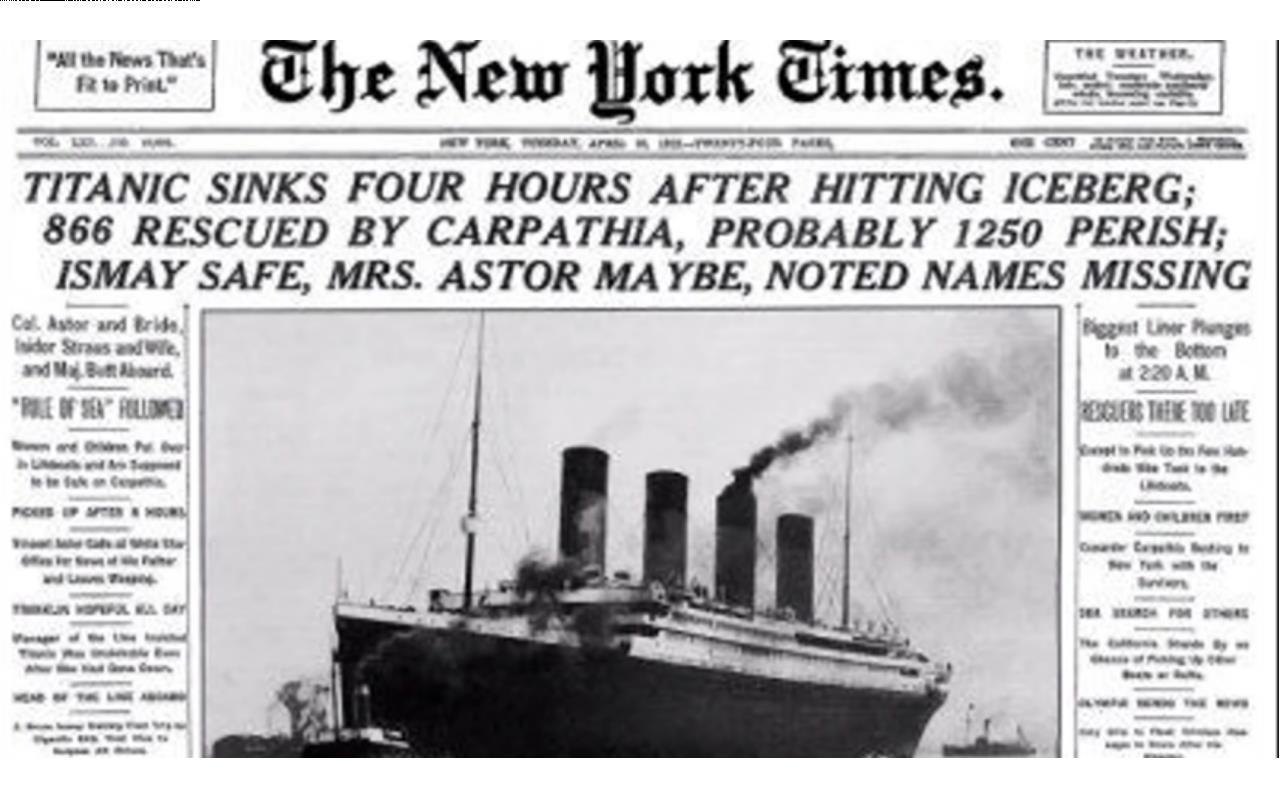

▲ 图1.3.1 戴维·萨尔诺夫与爱德华·J·纳里
第二年,即 1913 年,21 岁的萨尔诺夫 参加了一个名叫霍华德·阿姆斯特朗 (Howard Armstrong) 的产品展示。 他想出了如何制造三极真空管、产生平滑的无线电波。 相比之前的方法,利用三极管可将信号放大 5,000 倍。 萨尔诺夫随后邀请阿姆斯特朗在马可尼公司的一座大楼里展示他的设备,他们在一个寒冷的小屋里连续呆了 13 个小时,接收来自世界各地的信号。
多年后,萨尔诺夫说: “无论外边多么的寒风凛冽,但当我第一次听到来自大西洋和太平洋彼岸的信号时, 内心涌现的激动热火将寒风点燃。”
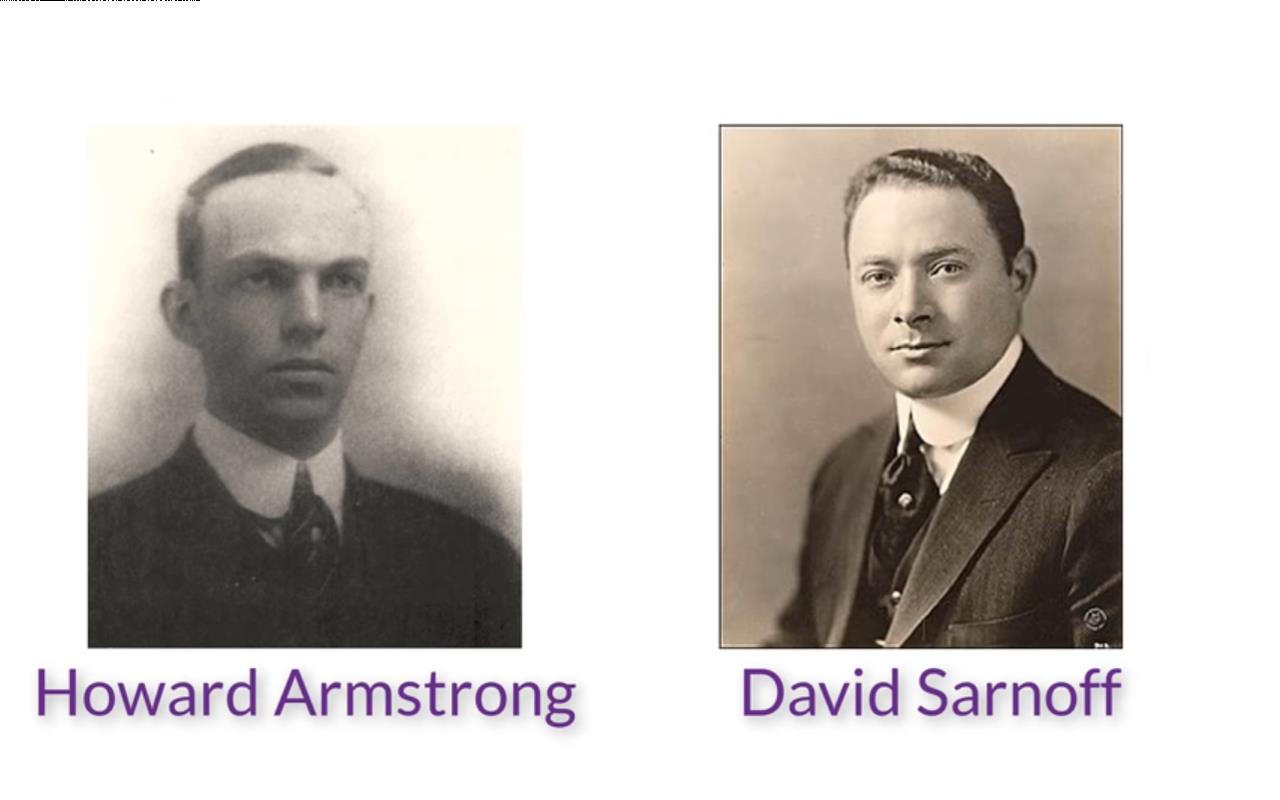
Sarnoff 试图让 Marconi 公司购买该专利,但老板们不同意。 可能是因为觉得他们并不是真空三极管的原始发明者,也没有相应的专利。 Sarnoff 和 Armstrong 很失望,但他们仍然是朋友。
两年后,萨尔诺夫向他的老板提出了一个建议。 “我正在考虑一项公司业务新的发展方向,可以使收音机向钢琴一样走进千家万户, 成为普罗大众的家庭用品’”。 他的顶头上司 纳利 很感兴趣,但高层认为这个想法比马斯克还激进,所以当时也没同意。


▲ 图1.3.2 戴维·萨尔诺夫的提议
四、信号变换
1917 年 4 月,美国加入了第一次世界大战,萨尔诺夫申请成为海军的志愿者,但被拒绝了, 因为他的工作对战争至关重要,或者如萨尔诺夫所想,因为反犹太主义。 与此同时,霍华德·阿姆斯特朗志愿参军并驻扎在巴黎,从事无线电系统方面的工作。


▲ 图1.4.1 在巴黎工作的霍华德·阿姆斯特朗
在欧洲,阿姆斯特朗听说德国人使用非常高频的无线电波,但不知道他们是怎么做到的, 因为当时的无线电波在大约 500 KHz 以上的频率下效果不佳。 几个月后,阿姆斯特朗在巴黎赶上了一场夜间轰炸。 正当他成为这场夜间轰炸的吃瓜群众的时候,他开始思考飞机发动机点火系统产生的高频无线电波。 他想知道如果将它们与接收器中产生的高频无线电波混合起来会发生什么。 突然间,他灵光乍现,有了解决高频问题的根本方法。 他知道当两个混合在一起的信号频率略有不同就会产生拍频。

如果您曾尝试在没有调音器的情况下给吉他调音就可能遇到这种现象。 当吉他发出两个频率略有不同的音符时,结果会发出嗡嗡的拍频声音。 阿姆斯特朗意识到他可以使用这种方法将高频信号转换成低频信号。


▲ 图1.4.2 吉他声音之间的拍频
下面让我们听听吉他产生的拍频声音。
这实际上并不是一个全新的想法。 1905 年,一个名叫雷金纳德·费森登 (Reginald Fessenden) 的人就为此申请了专利, 专利的内容就是混合两个不同频率的信号产生拍频, 底盘的拍频就可以通过耳机听到。 Fessenden 将其称为外差法。 hetero,代表两个不同的,dyne,表示力。
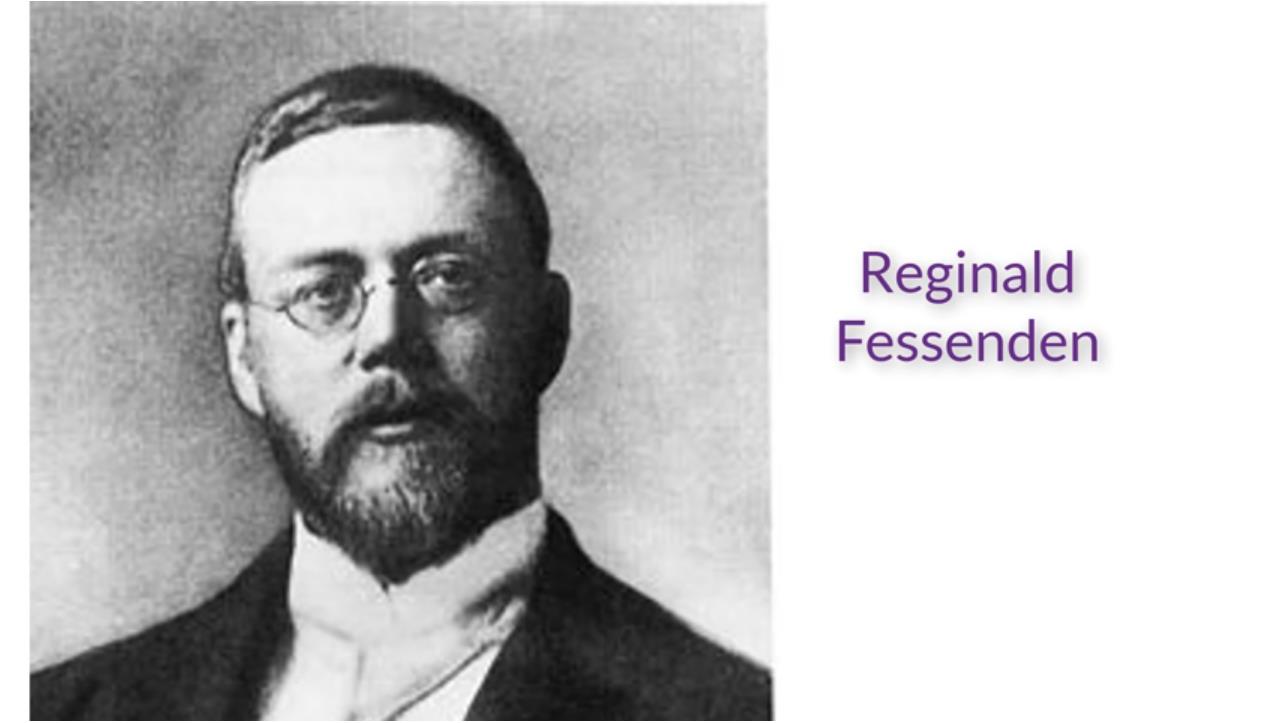
▲ 图1.4.3 雷仅纳德·费森登
阿姆斯特朗的想法是将信号混合起来,产生一个低频,但仍然高于听力或超声波的无线电波, 这样的低频电信号容易处理。 出于这个原因,阿姆斯特朗称他的想法为超外差法。 如果你看一下它的示意图,基本的想法还是一样的。 将获取无线电信号并将其与频率略有不同的另一个信号混合,产生拍频或中频。
超外差法的优点之一就是可以将任何广播电台的无线电信号都转成统一的中频信号。 这样就可以针对同一频率的中频信号优化后期的处理电路。 Armstrong 为此构建了一个电路原型,但对于商业用途来说最初的电路太大太复杂了。

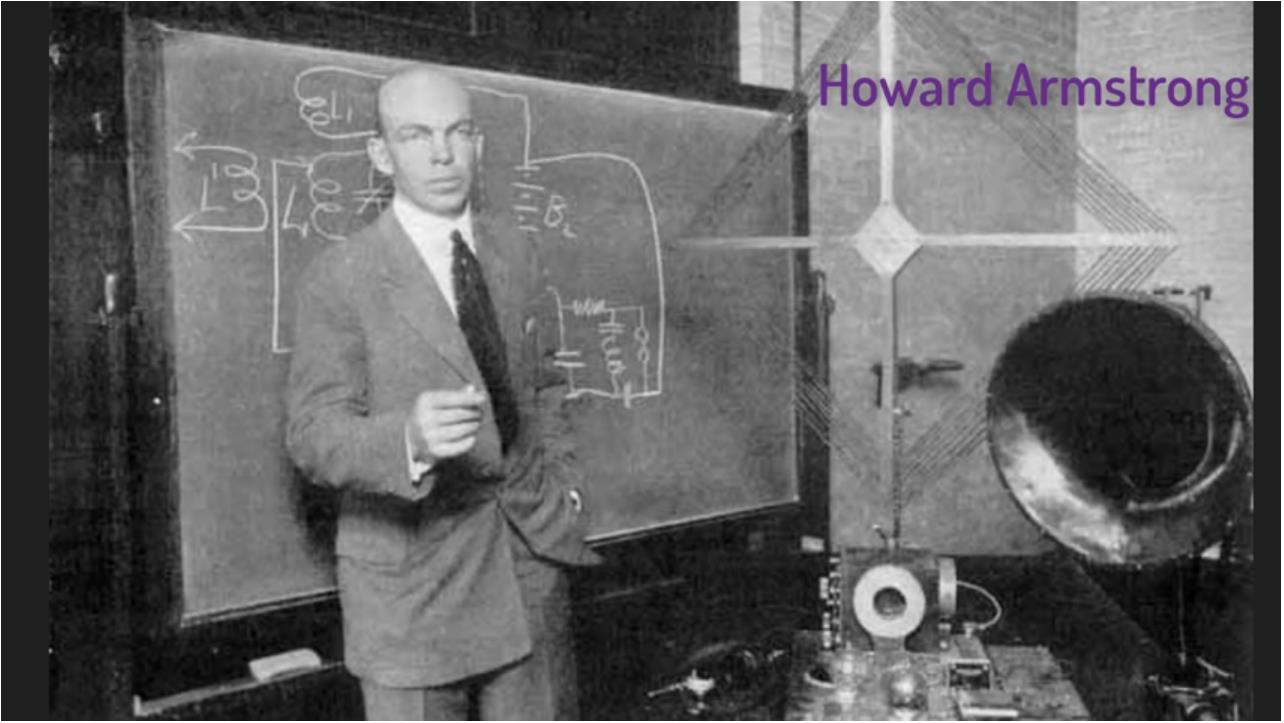
▲ 图1.4.4 霍德华·阿姆斯特构造的接收机电路
五、美国广播公司
1919 年战争结束后,萨尔诺夫的老板创立了一家全新的公司,最初的想法是将所有无线电通信都掌握在美国人手中。 因此,他将其称为美国无线电公司或 RCA。 经过几年发展,RCA 成功地获得了几乎所有与无线电有关的专利, 超过 2,000 项专利。
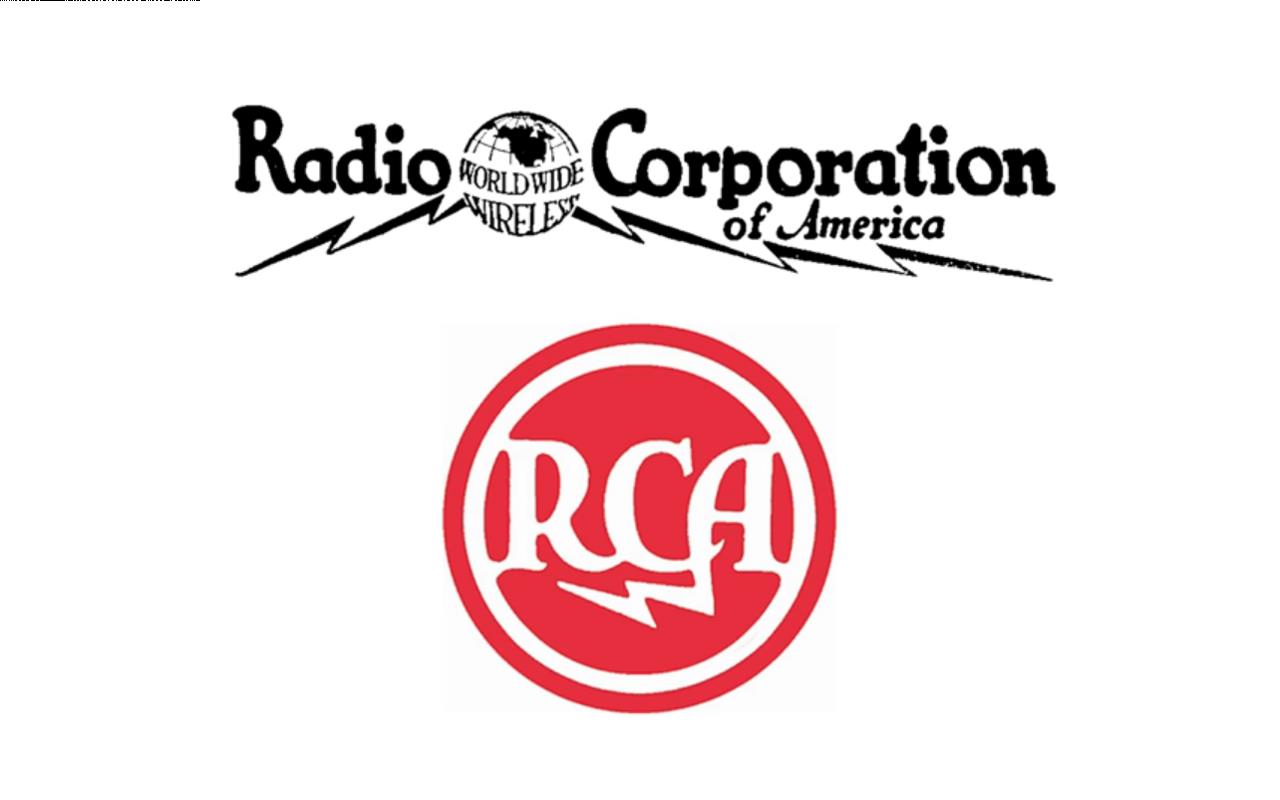
现在 Sarnoff 可以实施他的计划,使收音机成为“现代家庭必备用品”。 与此同时,在 1920 年至 1922 年间,阿姆斯特朗获得了高达 735,000 美元的现金和 60,000 股 RCA 股票, 使阿姆斯特朗 成为RCA 的专利最大股东, 其中还包括有那些最终效果不佳的专利。 此外,他结识了萨尔诺夫的秘书马里恩·麦金尼斯,两人坠入了爱河。
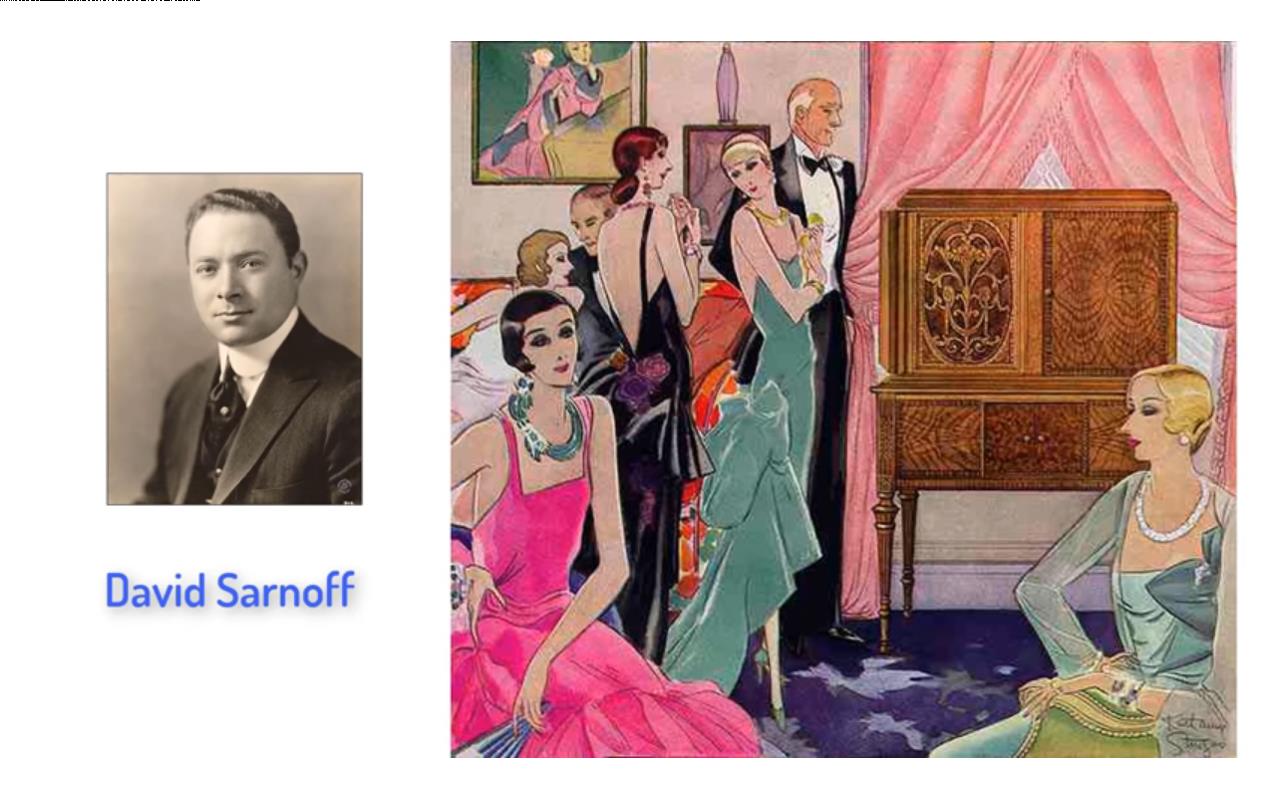
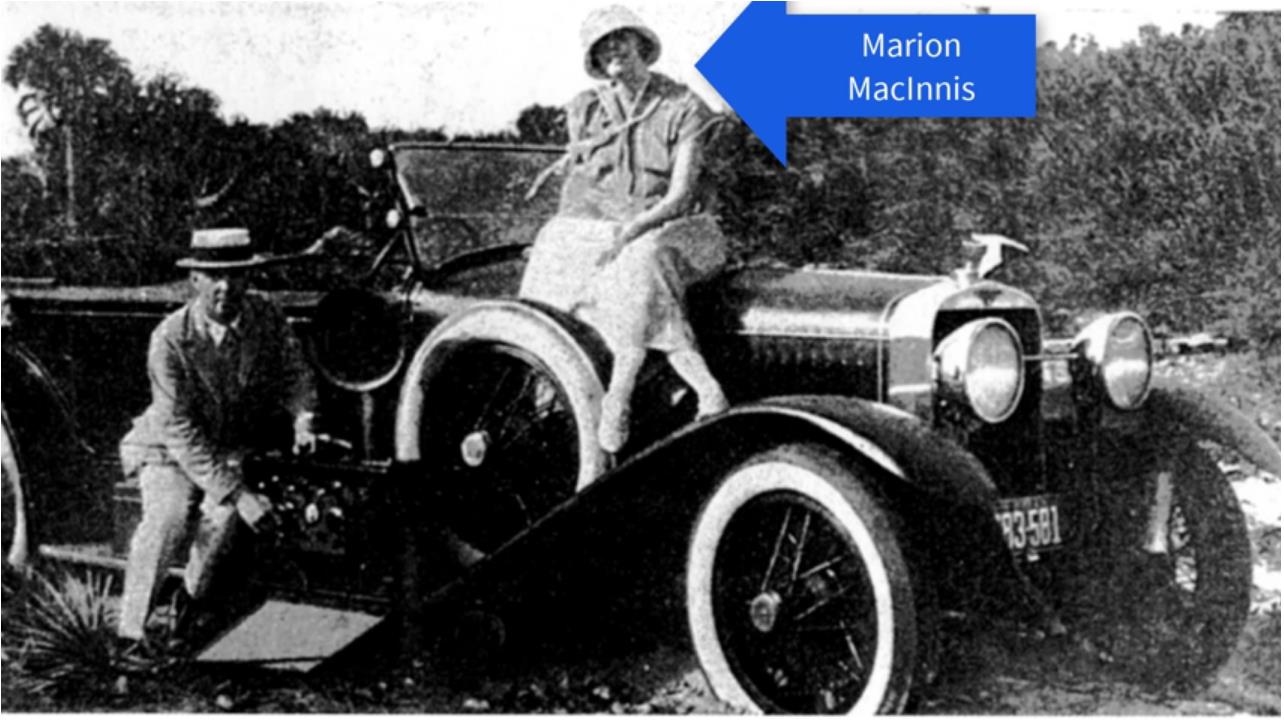
▲ 图1.5.1 阿姆斯特朗与他的老婆Maclnnis
1923 年 2 月,Armstrong 为 Sarnoff 展示了他的超外差无线接收机的简化版本。 Sarnoff 取消了之前数百万美元的订单,转而制作超外差无线接收机。 尽管接收方案进行了简化,但最初的设计对于大规模生产的系统来说还是困难重重。
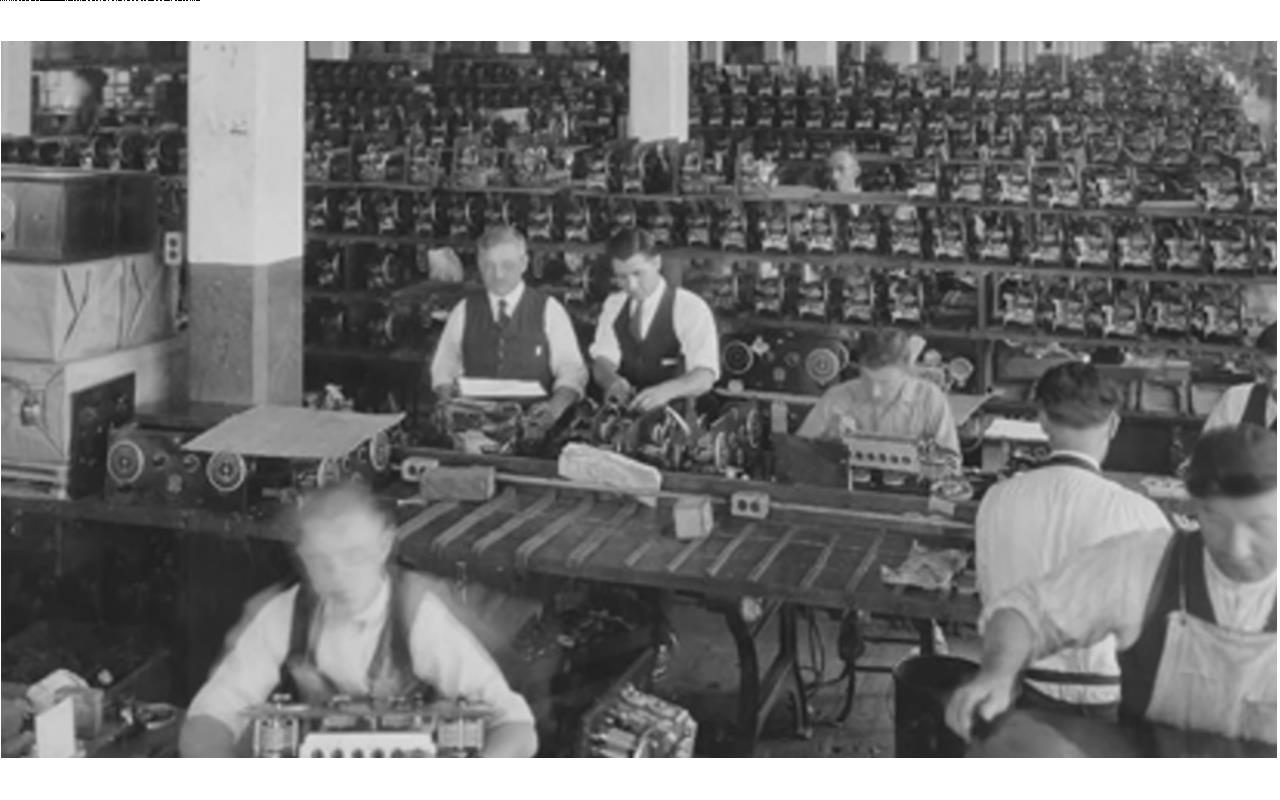
最后走投无路的萨尔诺夫说:“我该怎么办?” 他老婆Marion 说:“你为什么不叫 Armstrong 来?” 萨尔诺夫如梦初醒,急忙请回来阿姆斯特朗以及他的军友哈利·豪克, 最终挽救了公司的局面。
到 1924 年 2 月,RCA 终于定型了它的超外差接收器产品, 包括 Radiola AR-812,号称“无线电中的劳斯莱斯”,操作它只需要三个旋钮。


▲ 图1.5.2 Radiola AR-813 产品
六、超外差收音机
那么 Radiola 的控制装置是如何工作的呢? 早期的收音机中,人们使用了一个可调电容器,通过转动一个旋钮,可以改变电容的容量。 如果电容与一个线圈并联,就可以形成LC谐振回路。通过调整电容器可以改变谐振频率。
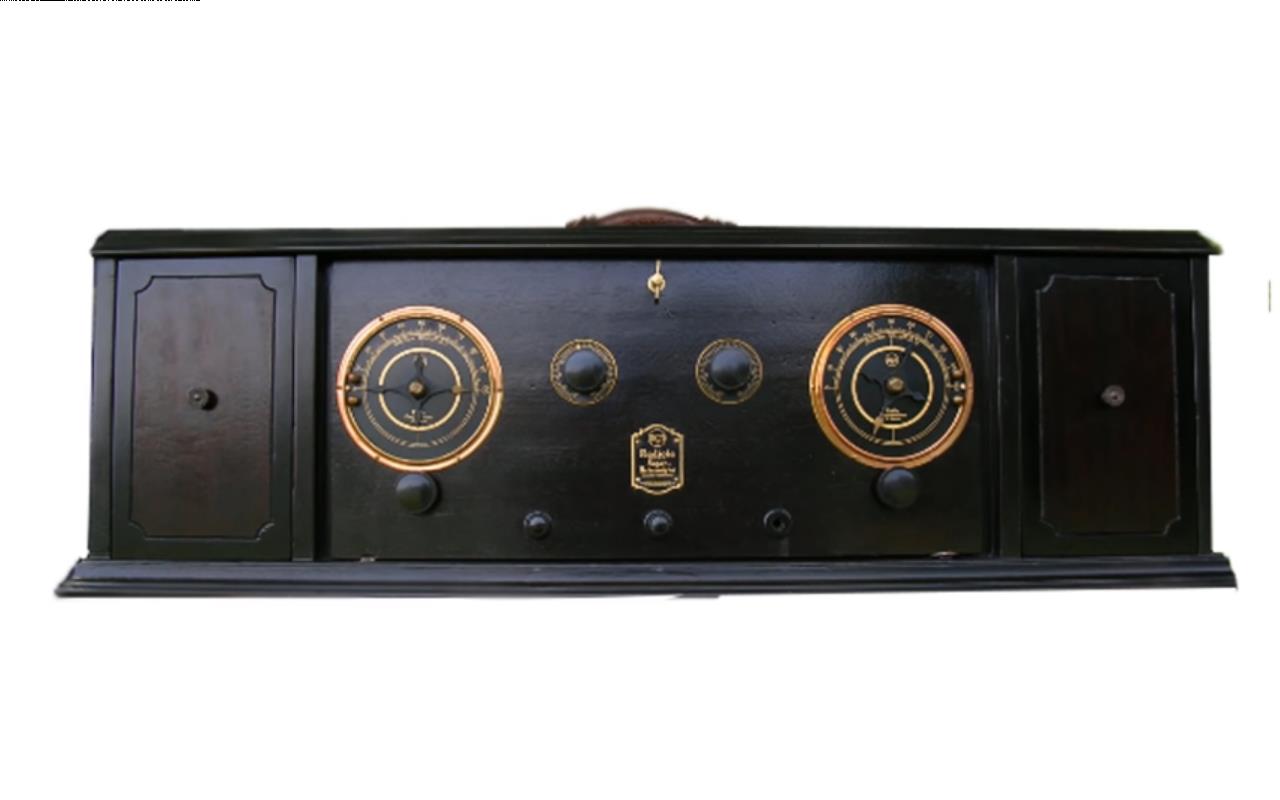
第一个旋钮改变了天线的谐振回路电容,可以控制收听哪个频率的广播电台。 第二个旋钮控制与输入信号混合的振荡频率。通过调整电容器对其进行调谐,直到产生的拍频或中频能够通过后面的放大检波电路,最终产生音频信号。 中频频率大约为 45 kHz。 最后一个旋钮控制音量。

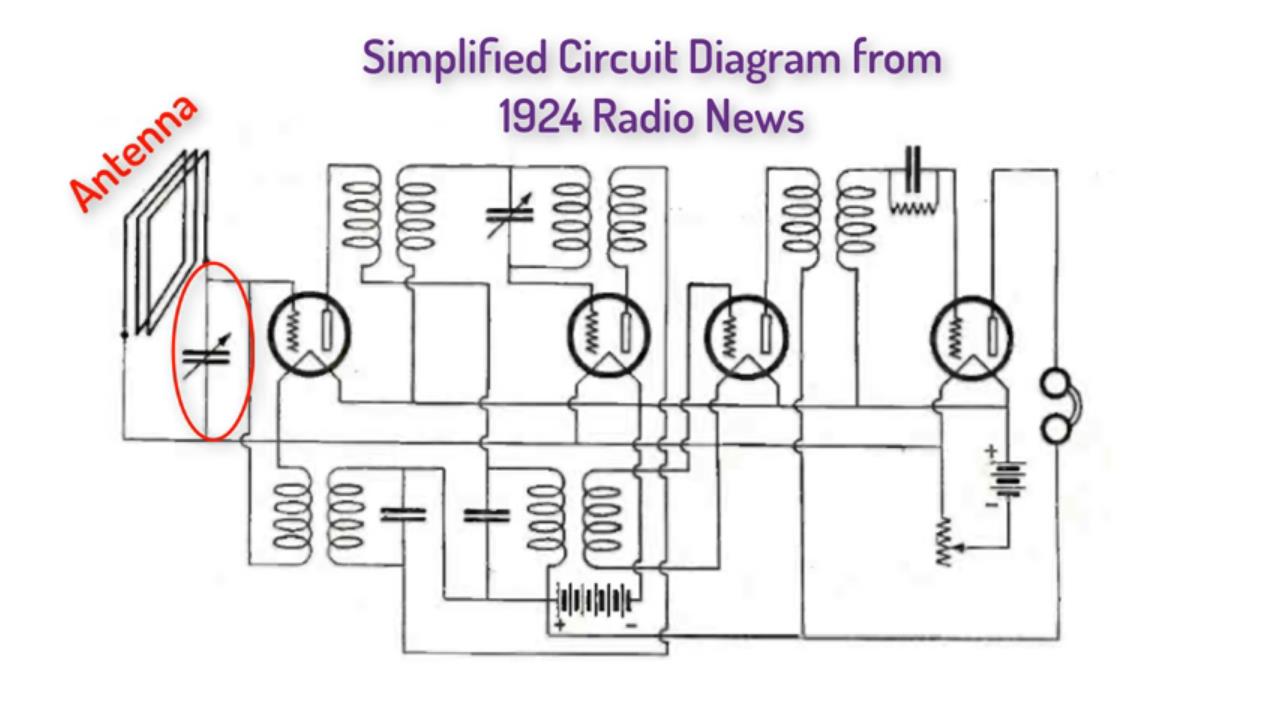
▲ 图1.6.1 简化后的收音机电路图
Radiola 使用 6 个真空三极管, 通过改变加热三极管灯丝串联电阻器的电阻来调节音量。 如果降低电阻,那么通过灯丝的电流就会增加,从而更多地加热灯丝。 随着灯丝变热,更多的电子可以从灯丝流出,从而增加耳机的音量。

七、广播帝国
在那之后,RCA 基本上垄断了无线电产业。 萨尔诺夫随后组建了美国第一家广播网络 NBC、 五大制片厂之一的雷电华影业, 并担任 RCA 总裁和广播、 电影和电视界的老板, 直到 1970 年退休, 享年 79 岁。


▲ 图1.7.1 收音机进入家庭生活
在 1924 年霍华德·阿姆斯特朗 又获得了 20,000 股 RCA 股票, 阿姆斯特朗给哈里·豪克 (Harry Houke) 开除了一张 100,000 美元的个人支票。 你可知道在1924 年当时人均工资年收入是 3,400 美元。
为了庆祝公司的成功,霍华德·阿姆斯特朗攀登了 RCA 400 英尺高的塔顶, 在上面还做了疯狂的杂技表演。 萨尔诺夫生气地写道,“如果你觉得这个平凡的宇宙已经装不下你了,你可以爱干啥就干啥,我不想和你争吵。只是请你好自为之,不要在祸祸RCA 公司的财产啦。” 志得意满的Armstrong不在乎,他有钱有名,最重要的是,Marion终于同意嫁给他。 似乎此时整个世界都在他的脚下,他终于登上了人生巅峰, 正走在成功的康庄大道上。
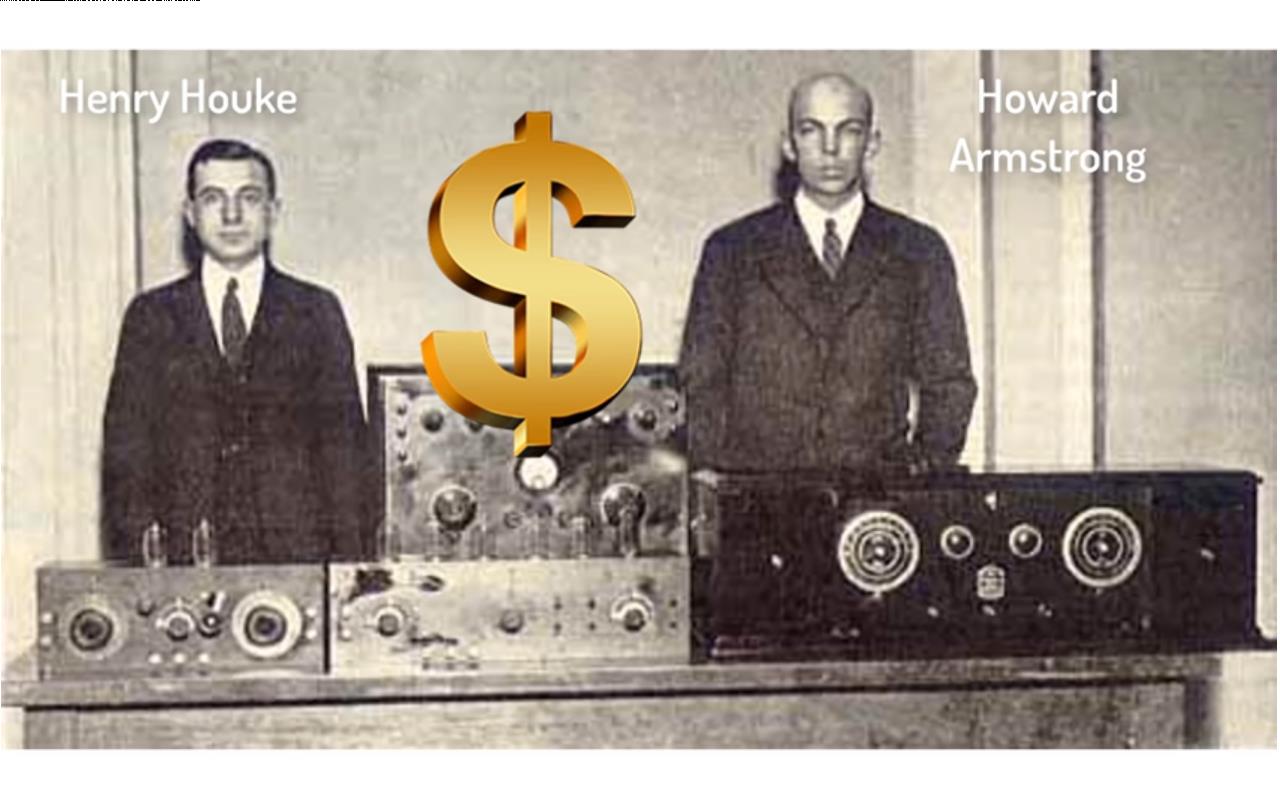

▲ 图1.7.2 人生巅峰的阿姆斯特朗
八、后记
不幸的是,萨尔诺夫是他垮台的主要原因。 阿姆斯特朗是如何发明 FM 收音机的? 为何毁掉了他与萨尔诺夫的关系,并最终走向了人生的终点? 这中间的故事我们下次接着聊。


▲ 图1.8.1 霍华德·阿姆斯特朗与他的收音机
02 英文原文
一、前言
The superheterodyne method is where two signals are mixed together to make a lower frequency signal that is easier to deal with. And according to Wikipedia, “virtually all modern radio receivers use the superheterodyne principle.” But how was it invented? How does it work? And what does that have to do with how radio became so popular? This is the story of Howard Armstrong, who invented it in the middle of a bombing raid, and David Sarnoff, who used Armstrong’s inventions to fulfill his improbable desire to make a broadcast empire with himself at the helm. Ready for the story? Let’s go. ♪ Electricity electricity ♪ ♪ Electricity electricity ♪
二、初入茅庐
Let’s start with David Sarnoff. Sarnoff was born in the Shtetl in Minsk, Russia in 1891 to poor Jewish painter. Think, Fiddler on the Roof, but with a painter. When Sarnoff was just a boy, his father left Russia to go to America to improve their fortunes. But when Sarnoff, his mother, and younger brothers joined him in New York, Sarnoff found that his father was unable to care for anyone. At the tender age of 9, Sarnoff became the breadwinner for the family. Years later he recalled that quote, “It was like being tossed into a whirlpool, a slum whirlpool and left to sink or swim.”
Sarnoff’s interest in wireless began when started delivering telegraphs for the Commercial Cable Company. He was actually looking for a job with the New York Herald, but he accidentally opened the wrong door. Sarnoff then spent a precious $2 out of his $5 a week paycheck to purchase a telegraph key. And he then taught himself how to be a telegraph operator. Soon, he switched to working for the Marconi Company, where he was occasionally allowed to send wireless messages when the main operators were sick.
One day in December of 1906, Guilermo Marconi himself visited his New York office and the bold fifteen-year-old introduced himself to the big boss. They had an instant report and at the end of the evening, Sarnoff became Marconi’s personal New York message boy, which mostly involved deliveries to Marconi’s many mistresses. With Marconi’s patronage, Sarnoff became a junior telegraph operator.
三、得到提升
He moved off to being a local manager by 1912 when the Titanic sank. Sarnoff then created a story where he was the first to hear of it in the United State, he wasn’t. That he was the only operator working, he wasn’t. And that he stayed up for 3 nights straight to hear the news, maybe. Due to his heroics, he was promoted to chief inspector and right hand man to the general manager, Edward J. Nally.
The next year, in 1913, the 21-yr-old Sarnoff went to a demonstration from a wonder kid named Howard Armstrong, who had figured out how to make triode vacuum tubes, create smooth radio waves and amplify signals up to 5,000 times more powerfully than before. Sarnoff then invited Armstrong to demonstrate his device at one of the Marconi Companies tower and they spent 13 hours straight in a frigid shack receiving signals from around the world.
Years later Sarnoff said, “Whatever chills the air produced were more than extinguished by the warmth of the thrill which came to me at hearing for the first time signals from across the Atlantic and across the Pacific”.
Sarnoff tried to get the Marconi company to buy the patent but they refused, possibly because they were in (indistinct) with the original inventor of the vacuum triode. Sarnoff and Armstrong were disappointed but they remained friends.
Two years later, Sarnoff sent his boss a proposition. “I have in mind a plan of development which would make radio a “household utility” in the same sense as the piano”. Nally was interested but the higher ups thought it was too radical, so that too came to nothing at the time.
四、信号变换
In April of 1917, America joined World War I, and Sarnoff attempted to volunteer for the navy but was denied because his job was vital to the war effort or, as Sarnoff thought, because of anti-Semitism. Meanwhile, Howard Armstrong volunteered for the army and was stationed in Paris, working on radio systems.
In Europe, Armstrong heard that the Germans were using very high frequency waves, but he didn’t know how they were doing it, as radio waves at that time, did not work well above about 500 KHz. Months later, Armstrong was watching a night bombing raid in Paris. He started thinking about the high frequency radio waves produced by the motor ignition systems in the airplanes. He wondered what would happen if he combined them with the high frequency radio waves, he could create in a receiver. Suddenly, he had a radical solution to the high frequency problem. He knew that if two waves were combined with slightly different frequencies, then they produce the beat frequency.
You might have heard this phenomenon if you’ve ever tried to tune a guitar without a tuner. When you make two notes that are at slightly different frequencies, the result is a whomp whomp sound. (whomp sound). Armstrong realized that he could use this method to make lower frequency waves out of high frequency ones.
This was an actually not a completely new idea. In 1905, a man named Reginald Fessenden had patented his plan to mix two signals so that the beat frequency was audible and you could hear it on headphones. Fessenden called it the heterodyne method. hetero, for two different, dyne, for force.
Armstrong’s insight was to combine signals to produce radio waves that were manageable but were still above hearing, or super sonic. For that reason, Armstrong called his idea the superheterodyne method. And if you look into a schematic of it, the basic idea is still the same. You take a radio signal and mix it with another signal at a slightly different frequency, producing the beat frequency or intermediate frequency.
One of the advantages of the superheterodyne method is that you can set it up so that the intermediate frequency is constant for any radio station you’re listening to. That way, the bulk of the equipment is optimized to amplify that set frequency. Armstrong built a working system but it was too big and complicated for commercial use.
五、美国广播公司
When the war ended in 1919, Sarnoff’s boss created a brand new company with the idea of keeping all radio communication in the hands of Americans. For this reason, he called it the Radio Company of America or RCA. After a few years of wrangling, RCA managed to have the patents for basically everything to do with Radio, over 2,000 patents.
Now Sarnoff could implement his scheme to make radio a “household utility”. Meanwhile, between 1920 and 1922, Armstrong received a whopping $735,000 in cash and 60,000 shares of RCA stock, making Armstrong RCA’s biggest stockholder for his patents, even the ones that didn’t end up working out that well. In addition, he also met Sarnoff’s secretary, Marion MacInnis, and fell in love.
In February of 1923, Armstrong demonstrated a simplified version of his superheterodyne method for Sarnoff. And Sarnoff scrapped millions of dollars of past orders to make all of their radio equipment superheterodyne. Still, this original plan wasn’t workable for mass produced systems.
Finally, the exacerbated Sarnoff said, “What do I do?” To which Marion said, “Why don’t you call in Armstrong?” Armstrong swooped in, and with an army friend of his named Harry Houke, saved the day.
By February of 1924, RCA finally had its superheterodyne receivers including the Radiola AR-812, the “Rolls Royce of Radio” which only needed three controls.
六、超外差收音机
So how did the Radiola’s controls work? Well, in the early radios, they used an adjustable capacitor, where if you turned a knob, more or less metal was put in parallel with each other, which changed how much charge it can hold. If a capacitor is discharged through a coil, it vibrates at a certain frequency. So by adjusting the capacitor, you’re changing the frequency of oscillation.
The first knob changed the capacitance of one capacitor, which controlled the frequency of resonance with the antenna. In other words, it controlled which frequency radio station you were listening to. The second knob controlled the frequency of the oscillations that you were mixing with the incoming signal. Once again, by adjusting a capacitor, you would tune this until the beat frequency or the intermediate frequency was at the note that the rest of the electronics was maximized for, around 45 kHz. The final knob was for the volume.
The Radiola used 6 vacuum triodes and you adjusted the volume by changing the resistance of a resistor next to a battery that was heating the filament of the triodes. The idea is, if you lower the resistance, then the current through the filament increases which heats the filament more. As the filament gets hotter more electrons can flow from the filament, which increases the volume in the headphones.
七、广播帝国
Whew! After that, RCA had basically a monopoly on radio. Sarnoff then formed America’s first broadcasting network, NBC, one of the big five studios, RKO pictures, and reined as the president of RCA and boss of radio, movie, and the television world until he retired in 1970 when he was 79 yrs old.
Meanwhile, back in 1924, Howard Armstrong was rewarded with another 20,000 shares of RCA stock and Armstrong wrote Harry Houke a personal check for $100,000. To give you a sense of how much that was, the average income in 1924 was $3,400.
Howard Armstrong celebrated by climbing the top of RCA’s 400 foot tower and doing insane acrobatics to show (indistinct). Sarnoff crossly wrote, “If you have made up your mind that this mundane universe of ours is not a suitable place for you to be spending your time in, I don’t wanna quarrel with your decision, but keep away from the property of the Radio Corporation.” Armstrong didn’t care, he was wealthy, famous, and most importantly, Marion had finally agreed to marry him. Armstrong was literally and figuratively on top of the world. Which meant there was only one way to go.
八、后记
And unfortunately, Sarnoff was a large part of his downfall. How Armstrong invented FM radio, and was so amazing that it destroyed his relationship with Sarnoff and eventually his life, is next time on the Secret History of Electricity.
■ 相关文献链接:
● 相关图表链接:
- 图1.1.1 超外差式接收机
- 图1.2.1 戴维·萨尔诺夫小的时候
- 图1.2.2 萨尔诺夫购买到的电报按键
- 图1.2.3 马可尼与萨尔诺夫
- 图1.3.1 戴维·萨尔诺夫与爱德华·J·纳里
- 图1.3.2 戴维·萨尔诺夫的提议
- 图1.4.1 在巴黎工作的霍华德·阿姆斯特朗
- 图1.4.2 吉他声音之间的拍频
- 图1.4.3 雷仅纳德·费森登
- 图1.4.4 霍德华·阿姆斯特构造的接收机电路
- 图1.5.1 阿姆斯特朗与他的老婆Maclnnis
- 图1.5.2 Radiola AR-813 产品
- 图1.6.1 简化后的收音机电路图
- 图1.7.1 收音机进入家庭生活
- 图1.7.2 人生巅峰的阿姆斯特朗
- 图1.8.1 霍华德·阿姆斯特朗与他的收音机
以上是关于戴维·萨尔诺夫,霍华德·阿姆斯特朗以及超外差无线接收机的主要内容,如果未能解决你的问题,请参考以下文章

